R Cygni's Place in AAVSO History
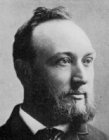 |
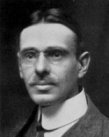 |
| Founders of the AAVSO: Edward Pickering (top) and William Tyler Olcott (bottom) |
In the early 1900s, Edward Pickering of the Harvard College Observatory (HCO) was devoting much of his time to the then neglected field of variable star astronomy. For years, Pickering monitored the brightness of variables with the assistance of a small group of volunteers. In 1909, an aspiring amateur astronomer named William Tyler Olcott attended a lecture given by Pickering about the subject near and dear to Pickering's heart. Impressed by the presentation of variable star light curves and star charts, Olcott returned to his home in Norwich, Connecticut and enthusiastically wrote a letter to Pickering to see if he could aid in the effort to observe the curiously varying stars. Since Pickering needed help monitoring long period variable stars, he decided to take the anxious observer up on his offer. Subsequently, Leon Campbell (the then Harvard assistant and variable star observer, who later became the Director of the AAVSO) was sent to Olcott's home in Connecticut to "initiate Mr. Olcott in the art of variable star observing." Using a 3-inch refractor, Olcott made his first variable star estimate at 8:54 EST on January 23, 1910, with the variable star of choice being the famed Omicron Cet, or more commonly known as Mira.
In March of 1911, Olcott, who was now fully engulfed in the world of variable star observing, published an article in Popular Astronomy entitled "Variable Star Work for the Amateur Astronomer." He begins his article by saying, "In all the literature of Popular Astronomy and particularly in the books written for the benefit of those possessed of only a modest telescopic equipment, we find, strange to say, little if anything on the subject of variable stars." As an advocate for the field, Olcott's mission was to change this view. When the article was published, the author was familiar with 25 variable stars. (To put this into perspective, at the time there were only about 1000 confirmed variable stars, whereas today there are tens of thousands of known variable stars with numbers growing nearly day-by-day.) Six of the 25 variable stars in his regiment, he felt, were even easier to find and "...once found and observed for a time, the fascination of the work is sure to stimulate him [or her] to further efforts." In the article, Olcott mentions only long period variables, in order to spare the observer of "great demands on the observer's time as is the case with the observation of variable stars of short period."
 |
| A portion of the chart for R Cyg which accompanied Olcott's 1911 Popular Astronomy article. |
Although six stars were noted in his writing, Olcott paid special attention to 1934+49 R Cygni. With this variable as an example, Olcott described how to make and record variable star observations. (The remaining stars were 0727+08 S Canis Minoris, 1805+31 T Herculis, 1621+19 U Herculis, 1702-15 R Ophiuchi, and 1037+69 R Ursae Majoris.) He continued on in his article to say, "if the stars here mentioned are found and observed for a time, the fascination of the study will weave its spell, and the observer will be anxious to explore the heavens for new fields." Fortunately for the AAVSO, this prophecy came true. For the collaborated efforts of Pickering and Olcott resulted in the founding of the AAVSO. (For more information about the evolution of the AAVSO, see our History of the AAVSO pages.)
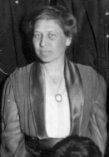 |
| Helen Swartz |
The first observation of R Cyg archived in the AAVSO International Database is that of Helen Swartz, which she made on what she reported to be a clear night with a 3-inch telescope from her home in Norwalk, Connecticut. The photographic 11.6 magnitude observation, which was recorded on October 2nd of 1902, was presumably sent to Pickering's HCO program to monitor the long period variable stars. Some of the other pre-AAVSO R Cyg observers were J.H. Eadie of Bayonne, New Jersey; Vassar College in Poughkeepsie, New York, including Ida Whiteside and Mary Whitney; and McCormick Observatory in Charlottesville, Virginia. Since that time, the AAVSO has archived more than 35,500 observations of this variable star alone!
Getting to Know R Cygni
| Like many parameters in astronomy, the magnitude scale is based on an antiquated system. The scale was set so that the brightest stars in the sky were considered to be of first magnitude while stars just visible to the unaided eye were of sixth magnitude. In the 19th century, Norman Pogson noticed that the interval of 5 magnitudes (1 to 6) corresponded closely to a factor of 100 in the energy output of stars measured at the earth -- this is known as the Pogson Ratio. |
The variability of R Cygni was first discovered by Norman Pogson, the father of the magnitude scale of stars, in 1852. Studies since its discovery reveal that R Cyg has a mean visual magnitude of 7.5 at maximum and 13.9 at minimum, a mean period of 429.2 days, and is of spectral type S (Wallerstein et al. 1987). With its large amplitude light variation, long period, and spectral type, R Cyg is classified as belonging to the pulsating cool red giant class of variable stars, known as the Mira variable stars. (For a review of this class of stars, see the December 1998 VSOTM for Mira and the April 2001 VSOTM for R Leonis, as well as the special edition of the Journal of the AAVSO, which contains the proceedings of the AAVSO session on Mira stars.)
 |
| Click on the above image to see an enlarged view of the 1975 and 1983 maxima of R Cygni. |
Light variations of Mira stars are not necessarily periodic in phase and amplitude, as can be seen with R Cyg. A look at the light curve of R Cyg (seen below) reveals a pattern of alternating bright and faint episodes of maximum light. Studies show that there is a correlation between the brightness at maximum and the interval from the previous cycle. That is, it seems that fainter maxima take place at a time later than the normal period and are subsequently followed by maxima earlier than the average period (Wallerstein et al. 1985). At the extrema of faint and bright maxima for R Cyg, the 1983 maximum of R Cyg appears as the faintest maximum on record at an average visual magnitude of 9.9, while the 1975 maximum was the brightest shining at an average visual magnitude of 6.2. The brightness at minimum light is seen to vary also, but not nearly as greatly as it does at maximum light.
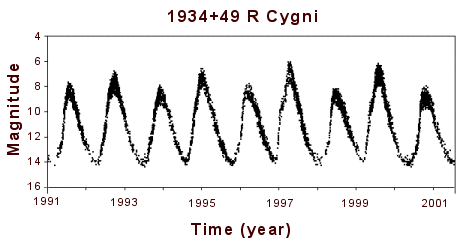 |
| A portion of the light curve for R Cygni from the AAVSO International Database. Shown is a decade in review for the popular Mira-type long period variable star. |
Observing R Cygni
R Cyg is among one of the select stars cited in the AAVSO's Stars Easy to Observe list, and thus, is recommended for new and old observers alike. R Cyg can be found at the northwestern wing of the swan constellation of Cygnus. Nestled between the bright stars of iota and delta Cyg, R Cyg is relatively easy to find. The AAVSO finder chart for the constellation of Cygnus may be used to find its location amongst the myriad of stars. The "b", "d", and "e" scale charts for R Cygni may then be used to make brightness estimates of the variable as it changes in magnitude.
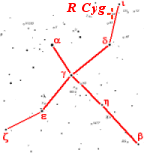 |
 |
| R Cygni's place in the constellation of Cygnus. |
Observers should exercise some caution, however, when observing stars that are red in color, as is R Cyg. Red stars tend to excite the retina more than blue stars when they are viewed for a long time, making the red stars appear brighter than they are -- a phenomena known as the Purkinje effect. Observers are advised to look as quickly as possible at the field and make a brightness estimate before falling subject to the fated effect.
Since R Cyg is located at a declination of +50 degrees (epoch 2000), it may be seen by many in the Northern Hemisphere as a circumpolar star. Currently, as of November 2001, R Cyg is rising in magnitude as it approaches its anticipated bright maximum. Observers should plan to observe R Cyg once a week throughout its entire cycle, while recording the decimal portion of the Julian Date to one decimal place. Observations may then be submitted to the AAVSO where they will be added to the 90+ year data archives.
A Balanced Variable Star Diet
Echoing the sentiment that finished off the April 2001 VSOTM R Leonis, observers are greatly encouraged to add Mira stars, such as R Cyg, to their observing programs. Miras are the variable stars that benefit most from amateur participation. Automated telescopes simply do not monitor such stars for long enough time periods to see the long-term changes that have been seen to occur in many of the stars of this class. Even if you are a die-hard cataclysmic variable star fan, adding a Mira or two to your variable star diet will ensure balanced nutrition to the AAVSO International Database.
If you have an appetite for some long period variable stars, you may wish to refer to AAVSO Bulletin 64: Predicted Maxima and Minima for Long Period Variables, which is published on a yearly basis. Here you will find anticipated dates of maximum and minimum activity for 562 long period variable stars. This is a valuable tool for those observers looking for bright stars to view with their moderate equipment, or for those with more advanced means looking to go after faint minima.
"...and it is a fact that only by the observation of variable stars can the amateur turn his modest equipment to practical use, and further to any great extent the pursuit of knowledge in its application of the noblest of the sciences." -- William Tyler Olcott
For More Information
A wealth of Mira-related information may be found in the "Proceedings of the AAVSO Session on Mira Stars Commemorating the 400th Anniversary of the Discovery of Mira" published in the Journal of the AAVSO, Vol 25, No. 2.
Additionally, see:
- AAVSO "b", "d", and "e" scale charts for 1934+49 R Cyg
- AAVSO constellation finder chart for Cygnus
- April 2001 VSOTM for R Leonis
- December 1998 VSOTM for Mira
- Fortier, Edmund. "The Legacy of William Tyler Olcott." Sky & Telescope, November 1990, 536-539.
- Mattei, J.A. AAVSO Bulletin 64: Predicted Maxima and Minima for Long Period Variables for 2001
- , 2001.
- Olcott, William Tyler. "Variable Star Work for the Amateur With a Small Telescope." Popular Astronomy, March 1911, 129-142.
- Waagen, Elizabeth O. "William Tyler Olcott, 1873-1936." Journal of the AAVSO, 24, 1996, 50-57.
- Wallerstein, George, Kenneth H. Hinkle, James F. Dominy, Janet A. Mattei, Verne V. Smith, and J.B. Oke. "The Spectrum of R Cygni During its Exceptionally Low Maximum of 1983." Monthly Notices of the Royal Astronomical Society, 215, 1985, 67-76.
This month's Variable Star of the Month was prepared by Kerri Malatesta, AAVSO Technical Assistant.

